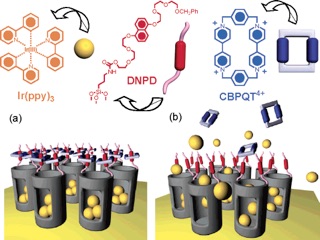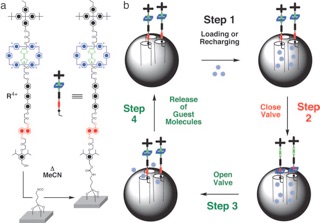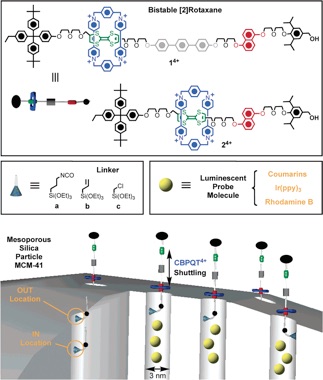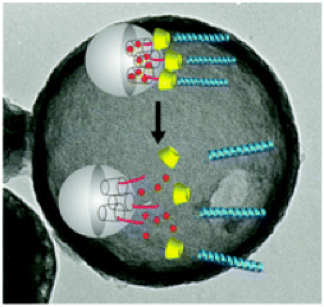Reduction/oxidation

A functioning nanomachine in the form of a supramolecular nanovalve that opens and closes the orifices to molecular-sized pores and releases a small number of molecules on demand is reported.


The rotaxane-modified MCM-41 constitutes a class of organic-inorganic hybrid nanoparticle that utilizes the mechanical movement within a mechanically interlocked molecule to control trapping and release of guest molecules. The valve is controlled by simple redox chemistry with mild redox reagents.
Redox-switchable [2]pseudorotaxanes and bistable[2]rotaxanes, having a cyclobis(paraquat-p-phenylene) (CBPQT4+) tetracationic ring, can be tethered to porous silica thin films and to MCM-4114 to act together as supramolecular and molecular nanovalves, respectively. In addition, a supramolecular nanovalve system (switchable pseudorotaxane) based on dibenzo[24]crown-8/dialkylammonium ion complexation that responds to a range of bases.

The system operated successfully under pH control (deprotonation of ferrocenedicarboxylic acid at pH = 4) in the presence of cucubit[7]uril, and redox control (oxidation of ferrocenedicarboxylic acid) in the presence of β-CD.


Oligopeptides are part of this nanovalve system in peptide modified mesoporous silica nanocontainers for the controlled release of drugs. The peptides decorating the surface of the particles have two functions: to act as stimuli responsive nanovalves and to ensure efficient cell uptake. The peptide sequence used in this study has a high selectivity towards cellular membranes and at the same time allows the suspension of the silica nanocarrier in water solutions in order to perform in vivo
studies.

Light-driven dethreading in aqueous solution of the [2]pseudorotaxane (BHEENCBPQT4.) by excitation of the external photosensitizer, 9-anthracenecarboxylic acid, in the presence of a sacrificial reductant. Dioxygen is used to effect rethreading.
Copyright (c) 2013
Zink Research Group